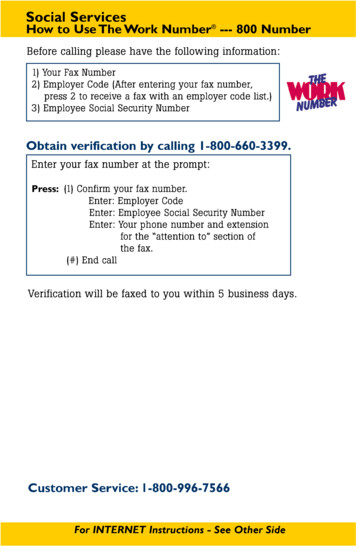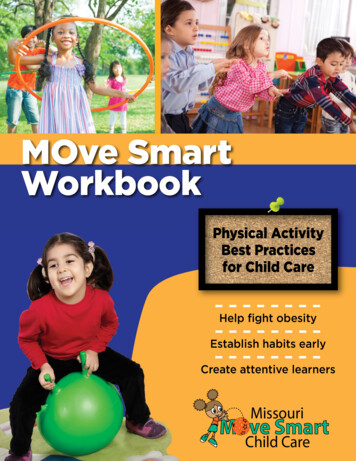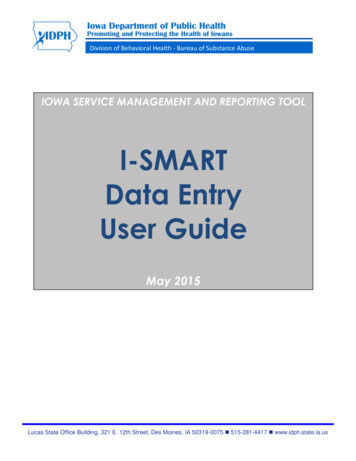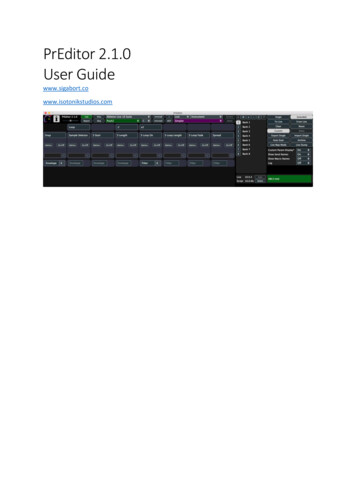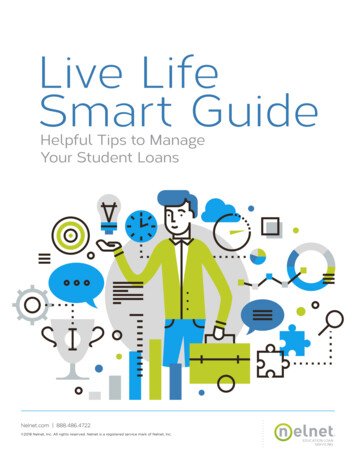
Transcription
Live LifeSmart GuideHelpful Tips to ManageYour Student LoansNelnet.com 888.486.4722 2018 Nelnet, Inc. All rights reserved. Nelnet is a registered service mark of Nelnet, Inc.EDUCATION LOANSERVICING
Table Of ContentsIntroduction 3The Life of a Student Loan 4Financial LiteracyManaging Your Money 6Set Your Financial Goals 7Budget Worksheet 8Strategies to Save Money 9Credit Card Tips 10How to Avoid Identity Theft 11Loan RepaymentFederal Student Loan Programs 1310 Things You Should Know About Student Loans. . . . . . . . . . . . . . . . . . . . . . . . . . . . . . . . . . . . . . . . . . . . . 15Student Loan Repayment Plans . . . . . . . . . . . . . . . . . . . . . . . . . . . . . . . . . . . . . . . . . . . . . . . . . . . . . . . . .16Income-Driven Repayment Plans . . . . . . . . . . . . . . . . . . . . . . . . . . . . . . . . . . . . . . . . . . . . . . . . . . . . . . . .18Loan Repayment Estimates . . . . . . . . . . . . . . . . . . . . . . . . . . . . . . . . . . . . . . . . . . . . . . . . . . . . . . . . . . . . 20Student Loan Terms to Know . . . . . . . . . . . . . . . . . . . . . . . . . . . . . . . . . . . . . . . . . . . . . . . . . . . . . . . . . . . 21Default ManagementHow to Avoid Delinquency and Default on Your Student Loans 29Trouble Making Payments? 30Four Easy Ways to Avoid Delinquency or Default on Your Student Loans 31Leaving SchoolGet Ready for Repayment . . . . . . . . . . . . . . . . . . . . . . . . . . . . . . . . . . . . . . . . . . . . . . . . . . . . . . . . . . . . . 33Servicer Contact Info 34Entrance Counseling 35Exit Counseling 36Nelnet.com 888.486.4722 2018 Nelnet, Inc. All rights reserved. Nelnet is a registered service mark of Nelnet, Inc.EDUCATION LOANSERVICING
IntroductionCongratulations on your decision to pursue a higher education! Upon completion, this can significantly boost yourearning potential. To help you build a healthy financial future, we want to provide any information we can to balance youreducational goals with good borrowing decisions. In combination, this guide and careful financial planning can help youset up your finances for success.When you borrow federal student loans, you have six months (a loan’s grace period) from the time you graduate or dropbelow half-time student status until you are required to start making payments (repayment). Nelnet is one of the federalstudent loan servicers who may process your student loan payments and answer your questions on behalf of the U.S.Department of Education. Our years of experience in the student loan and financial industries have given us a wealth ofknowledge that we want to share with you to help you be in the best possible financial position.How to Live Life Smart: Use this document to learn how to set a budget, pick a repayment plan, and more. If Nelnet is one of your servicers, create or log in to your Nelnet.com account to update your contact information andview account information including due dates, payment amounts, and repayment options. Review your Repayment Schedule that will be available in your Nelnet.com account after the third month of yourloan’s grace period (this is not a bill; it contains details about your federal student loans). Get the details on all of your federal student loans online through the U.S. Department of Education’s NationalStudent Loan Data System (NSLDS) at NSLDS.ed.gov. Review your monthly student loan billing statements. If Nelnet is one of your servicers, your Nelnet monthly billingstatement is sent about three weeks before your payment is due. You can choose to receive electronic or paperstatements at Nelnet.com.Nelnet.com 888.486.4722 2018 Nelnet, Inc. All rights reserved. Nelnet is a registered service mark of Nelnet, Inc.3EDUCATION LOANSERVICING
The Life of a Student LoanThis may be your first time filling out the FAFSATM and terms like “loan servicer” may be new to you.Don’t stress, here’s a chart that explains the process of student loans, scholarships, and repayment.STEP 2: THE AWARDING PROCESSSTEP 1: PLANNING FOR SCHOOLIf, in addition to scholarships andgrants, you need federal studentaid to help pay for college, you willhave to fill out the Free Applicationfor Federal Student Aid (FAFSA) atFASFA.gov.GOFAFSA.ACBBased on your FAFSA, your school’sfinancial aid office will decide howmuch aid to award you, and the U.S.Department of Education will thendisburse these funds.TTANGRANGRWhen funds are disbursed, they willbe sent directly to your school tocover educational costs. VSTEP 3: WHILE YOU’RE IN SCHOOLDVICERSLOAN SERIf federal student loans are part of your ward, the Department of Education will aassign your loans to a student loan servicerafter they are disbursed.Loan servicers help you manage yourstudent loans from disbursement to payoff. To learn more about the life of your l oans,visit Nelnet.com/Stages-Of-A-Student-Loan.STEP 4: AFTER SCHOOL AND BEYONDWhen you graduate or drop below ahalf-time enrollment status, you are notrequired to make payments on yourfederal student loans for six months.However, you can choose to start payingdown your loans early. This will saveyou money in the long run.Throughout yourrepayment period, yourstudent loan servicer will help you choose therepayment plan that’sright for you.Whether you havequestions about yourloans or are struggling tomake payments, let yourservicer know – we’rehere to help!Nelnet.com 888.486.4722 2018 Nelnet, Inc. All rights reserved. Nelnet is a registered service mark of Nelnet, Inc.4EDUCATION LOANSERVICING
FinancialLiteracyResources and Tips to Help you Get(and Stay) Financially StableNelnet.com 888.486.4722 2018 Nelnet, Inc. All rights reserved. Nelnet is a registered service mark of Nelnet, Inc.EDUCATION LOANSERVICING
Managing Your Money:Nine Tips to Achieving Financial Wellness1. Know Where Your Money GoesBe aware of how you are spending your money.A 5 cup of coffee five days a week costs you 100/month. Review items you spend your moneyon to find areas where cutting back can growyour savings account.2. Develop a BudgetPlan for your spending by developing a budgetand live within your means based on your monthlyincome. Make adjustments to remain within yourbudget, and don’t use a credit card to cover ashortfall or unnecessary purchases.3. Include Savings in Your BudgetPay yourself first. Treat your savings accountlike any other monthly bill by making a monthlypayment toward it.4. Plan for Major PurchasesAdjust your budget accordingly to build savingsfor your next major purchase without using credit.5. Save for EmergenciesA good plan is to have a minimum ofsix months salary available in your savingsaccount. While this goal will take time to achieve,it is important to strive for it so you’re preparedfor most unexpected emergencies.6. Plan for RetirementTake advantage of interest and market upturns bysaving for retirement early. Often your employer willhelp you save for retirement with a 401(k) plan. Youcan also benefit from pre-tax contributions using thismethod of retirement savings.7. Get Tax AdviceIf you have circumstances that create tax dilemmas(i.e., self-employed, own and/or lease property, etc.),make sure to seek tax advice from a professional forthe best outcome.8. Protect Your CreditYou have the right to pull a free credit report fromeach credit reporting agency once per year atAnnualCreditReport.com. Keep in mind thatlate payments will adversely impact your credit, aswill a failure to pay. You should immediately reportany credit issues or discrepancies to the credit reportingagency. Use your credit wisely and ensure yourreports are accurate.9. Keep Good Financial RecordsUse online tools as well as paper copies of receipts tokeep records of your pay stubs, banking information,taxes, insurance, and other documents important toyour financial situation.Nelnet.com 888.486.4722 2018 Nelnet, Inc. All rights reserved. Nelnet is a registered service mark of Nelnet, Inc.6EDUCATION LOANSERVICING
Set Your Financial GoalsHealthy financial habits start by setting sound financial goals. Develop a realistic path to achieving your goals byfilling in the chart below.General InformationMonthly Household Net (After Taxes) Income:Number of Dependents:Monthly Necessary Expenses:Your Age:Amount Remaining to Save for Goals:Expected Graduation Date:Identify goals, cost, timeline, savings method, and anticipated rate of return.Set your goalsGoal #1:Goal #2:Goal #3:Total cost of each goalCurrent funds availableTime needed to achieve each goalMonthly contribution to achieve goalFunding source for monthly contributionMethod for saving/investing for goalExpected interest rate/rate of returnThere could be risks that might keep you from reaching your goals.In many cases, insurance can help protect against these risks.Risks: Identify risks below that could keepyou from reaching your goals and then checkthe boxes for any insurance you have that canprotect you from each risk.Type of Insurance With Monthly CostLifeHealthDisabilityAutoHome/Renters Nelnet.com 888.486.4722 2018 Nelnet, Inc. All rights reserved. Nelnet is a registered service mark of Nelnet, Inc.7EDUCATION LOANSERVICING
Budget WorksheetIt’s easy to prepare a budget. Common categories are included in this worksheet – just fill in the amount you typically spendin the Budget column. Use the Actual column to record spending to see if your budget is on target or needs to be adjusted.Check your billing statements and receipts for the most accurate numbers.Monthly ExpensesBudgetActualDeductionsMonthly ExpensesBudgetActualPersonal and HealthSavings (to be set aside) Clothing Child Support/Alimony Personal/Care Products Other: Haircuts Monthly Dues/Fees HousingRent/Mortgage Payment Insurance (Health, Life) Utilities (e.g. Gas, Water, Electric) Doctor/Dentist Visits Home Insurance and Taxes Prescriptions/OTC Drugs Home Owner’s Association Fees Laundry/Dry Cleaning Cable/Satellite/Streaming Service Other: Internet EducationPhone Tuition Other: Books/Fees Supplies Credit Card Payments Other: Student Loans EntertainmentOther: Concerts/Movies Sporting Events Debt PaymentFoodGroceries Sports/Recreation Equipment Dining Out/Fast Food Music, Streaming Services, Video Games Campus Meal Plan Other: Other: Miscellaneous/UnexpectedGifts/Charity Car Payment Pet Supplies/Vet License and Registration Traffic Ticket Gas/Oil Car Repair Normal Car Maintenance Home Repair/Improvement Public Transit, Parking, Toll Entertaining Guests Other: Other: Monthly Net Income TransportationFamilyDay Care/Babysitting Monthly Spendable Income Activities/Lessons - Total Expenses (from above) Pet Sitting Other: Nelnet.com 888.486.4722 2018 Nelnet, Inc. All rights reserved. Nelnet is a registered service mark of Nelnet, Inc.8EDUCATION LOANSERVICING
Strategies to Save MoneyHousingTransportationSet your thermostat lowerUse public transportationUnsubscribe from your cable/satellite TV serviceCarpool with a friend or family memberTurn off the lights when not in useRide your bike or walkGet a roommate egularly have your oil changed and use couponsRfor auto maintenanceLive with parents or another relative Make sure your tires are properly inflatedEntertainmentDine out less frequentlyPersonal/Health at early and take advantage of happy hoursEand early bird specials ExerciseSplit or share meals with friends Drink alcohol in moderationMake your own lunch and bring it to work Give yourself your own manicure and/or pedicureUse restaurant couponsLearn to cook your own meals Use coupons or take advantage of specialsfor haircutsRent movies Cancel unused club or gym memberships o to the movie theater in the afternoon ratherGthan in the evening Buy generic and OTC medicationsVisit local libraries, museums, and parksParticipate in sportsRead a book or hike a trailFoodUse a shopping listUse couponsCompare prices Don’t smokeDebt Payments Stop using credit cards as a primary payment method Pay off the full balance on each credit card atthe end of the monthMiscellaneous Make a budget Consider wants vs. needsBuy in bulk Don’t spend money to relieve stressDon’t shop more than once a week Avoid impulse purchases such as coffee or candyDon’t buy what you can’t or won’t use Give homemade gifts or give the gift of servicerather than a retail itemNelnet.com 888.486.4722 2018 Nelnet, Inc. All rights reserved. Nelnet is a registered service mark of Nelnet, Inc.9EDUCATION LOANSERVICING
Credit Card TipsProperly managing a credit card is a big responsibility. Credit cards can help establish and improve your credit score if they’reused properly. They can also damage your credit score and get you into serious debt if you don’t know what you’re doing.Use the tips below to make sound financial decisions.1. Shop AroundSelect a card that has the lowest interest rate andfee structure, and be sure to read the fine print. You’llalso need to know about late charges, other fees, andgrace periods. Make sure you know the card’s AnnualPercentage Rate (APR) and how it’s calculated. Shoparound for the best deal and be wary of card offersthat seem too good to be true.2. Limit the Number of Cards You HaveOne credit card should be sufficient. Applying for a lotof credit at any given time can hurt your credit scoreand possibly make you a high credit risk. This canaffect your ability to get loans or rent an apartment.In addition, closing several credit cards at once willtrigger a decrease in your overall credit score.3. Set Your Minimum Balance LowThis helps you control your spending habits.Spending up to your credit limit – maxing out yourcredit card – suggests you could be a credit risk sinceyou might be likely to overspend.4. Pay off Your Balance Each MonthThis takes discipline, and it saves you money in the longrun. If you can’t pay off the entire balance on all of yourcredit cards, pay off your higher interest rate cards first,and always pay off more than the minimum balance.5. Avoid Late PaymentsLate payments are bad for your credit, and a creditcard company could use a single late payment asjustification for raising your interest rate. This couldcost you hundreds (or even thousands) of dollarsover time.6. Review Your Monthly StatementSave your receipts so you can carefully compare thecharges on your credit card receipts with your recordsto ensure an accurate monthly statement.7. Balance Wants vs. NeedsIf you’ve had problems with impulse spending, don’tcarry all of your credit cards with you. Considercarrying a single card for emergencies only. It alsohelps to think in terms of wants vs. needs when itcomes to spending money with your credit card. Byresisting the temptation to spend impulsively withcredit cards, you can maintain a healthy credit scorewith little risk of getting in over your head.8. Reconsider Large PurchasesIf you are considering putting a large purchase onyour credit card, put yourself through a waiting periodbefore you actually make the purchase. Remember, alarge purchase will need to be paid off sooner or later,and you want to make sure you’re paying the leastamount of interest on your credit cards as possible.9. Don’t Take Cash AdvancesBeware – the cash looks attractive, but interest accruesfrom the moment you accept the cash, and you will alsobe assessed transaction fees. This means a quick 20withdrawal from an ATM using your credit card couldeasily cost you 30 or more.REMEMBER: You’ll lead a much happier life if youtake control of your spending, instead of letting yourspending take control of you.Nelnet.com 888.486.4722 2018 Nelnet, Inc. All rights reserved. Nelnet is a registered service mark of Nelnet, Inc.10EDUCATION LOANSERVICING
How to Avoid Identity TheftIdentity theft occurs when a person commits fraud while posing as someone else. The threat of identity theft is real and cantake months or even years to recover from. Use the information below to familiarize yourself with the precautions you cantake to minimize the chance of becoming a victim and, if you are a victim, help you recover from the situation.Follow These Helpful Hints to AvoidBecoming a Victim of Identity Theft:Mail:Personal:1. Take outgoing personal and/or bill payments to U.S. PostalService mailboxes or drop them off inside a post office.1.2. Have the post office hold your mail when you are out of town.Order a copy of your credit report on a frequent basis (at leastannually, preferably quarterly). You can request your creditreport at AnnualCreditReport.com.2. If you have to give private information over the phone,ensure you are in a secure location.3. Shred all financial statements, billing statements, andpre-approved credit card offers.4. The IRS does not request personal/financial data through email,so don’t respond to any emails asking for that information.5. Check your financial accounts regularly.6. Select Personal Identification Numbers (PINs) and passwordscarefully so they can’t be easily guessed by someone else.7. Don’t give out private information over the phone or internetunless you have initiated the contact or know for certain towhom you are speaking.8. Destroy or complete a secure wipe of your computer’s harddrive if you are selling it, giving it away, or disposing of it.9. Don’t carry your Social Security card with you.10. Don’t carry your registration in your vehicle; instead carry it inyour wallet.11. M ake photo copies of all of the cards in your wallet and keepthem in a safe place.E-Commerce:1.Ensure you are using an ATM without someone watching you.2. Pay your bills online using a secure website.3. Avoid entering your credit card number online unless it isencrypted on a secure website.3. Don’t leave mail sitting in an unprotected mailbox.Banking:1. Review monthly bank and credit card statements for mistakesor unfamiliar charges.2. Have your paychecks directly deposited into your bank account.3. Avoid providing personal information over the phone or viathe internet.If You Are – or Become – a Victim of IdentityTheft, Follow These Steps to Protect Yourself:1. Contact the Federal Trade Commission (FTC) atFTC.gov or 877.438.4338.2. Contact the fraud departments of any one of the majorcredit reporting agencies: Equifax . 800.525.6285 Experian . 888.397.3742 TransUnion . 800.680.72893. Close the accounts that have been used fraudulently.4. File a police report.5. Keep an identity theft log for your personal records.6. Contact other agencies that might be involved: Social SecurityAdministration’s Fraud Hotline (800.269.0271), U.S. PostalInspection Service (888.877.7644), and the Internal RevenueService (800.829.0433).Nelnet.com 888.486.4722 2018 Nelnet, Inc. All rights reserved. Nelnet is a registered service mark of Nelnet, Inc.EDUCATION LOANSERVICING
LoanRepaymentRepayment Plan Options and MoreNelnet.com 888.486.4722 2018 Nelnet, Inc. All rights reserved. Nelnet is a registered service mark of Nelnet, Inc.EDUCATION LOANSERVICING
2018–2019 Federal Student Loan ProgramsWhat Is a Federal Student Loan?Federal student loans are funds borrowed from the U.S.Federal Government that you must repay, along with theinterest that accrues. A federal student loan allows youand your parents to borrow money to help pay for collegethrough federal government programs.What Is a Private Student Loan?Private loans are non-federal loans issued by privatelenders like banks or credit unions. Private student loansoften have higher interest rates and loan fees1 than federalstudent loans, typically require a credit check, and do notprovide as many flexible repayment options.How Can I Tell the Difference?If you are not sure whether you’re being offered a private orfederal student loan, check if the name of the loan includesthe word “federal.” If not, ask your school’s financial aidoffice. Often, private loans are marketed directly to studentborrowers. If you do get a private loan, let your school’sfinancial aid office know so they can counsel you on futureloans and financial wellness.Why Are Federal Student Loans a BetterOption to Pay for College?Federal student loans offer borrowers many benefits nottypically found with private loans, including low, fixedinterest rates, a six-month grace period during whichno payments are due, income-driven repayment plans,options to lower or postpone payments, loan forgivenessor discharge based on your job or disability, and defermentoptions for military or volunteer service or if you return toschool. You should explore all of your federal student loanoptions before considering a private loan.What Types of Federal Student Loans Are Available and How Much Can I Borrow?Loan ProgramFederalPerkins LoansFederalDirect SubsidizedStafford LoansFederalDirect UnsubsidizedStafford Loans131EligibilityFixed AnnualInterest RateUndergraduatestudents: Up to 5,500Undergraduate andgraduate studentswho are enrolled atleast part time andwho demonstratefinancial needUndergraduatestudents who areenrolled at leasthalf timeMust demonstratefinancial needUndergraduate andgraduate studentsenrolled at leasthalf timeFinancial need isnot requiredAnnual Loan Limit5%Undergraduatestudents: For loansfirst disbursed on orafter July 1, 2018 andbefore July 1, 2019:5.05%Undergraduatestudents: For loansfirst disbursed on orafter July 1, 2018, andbefore July 1, 2019:5.05%Graduate students:For loans firstdisbursed on orafter July 1, 2018,and before July 1,2019: 6.60%The U.S. Department of Education does not assess late fees.Graduate students:Up to 8,000Amount receiveddepends on financialneed, amount of otheraid, and availability offunds at school 3,500– 5,500,depending on yearin schoolSee Annual Loan Limitchart below 5,500– 20,500(less any subsidizedamount received forthe same period)depending on yearin school anddependency statusSee Annual Loan Limitchart belowMaximum LoanAmount AllowedUpon GraduationDetailsUndergraduatestudents: 27,500Graduate students:Up to 60,000(this amount includesundergraduate loans)Your collegeis the lenderThe U.S. Departmentof Education is thelenderUndergraduatestudents: 23,000Dependent1undergraduatestudents: 31,000Independent2undergraduatestudents: 57,500The federalgovernment paysinterest while youare in school at leasthalf time, in grace, orin a defermentThe U.S. Departmentof Education isthe lenderYou are responsiblefor paying all intereston the loan startingon the date the loan isfirst disbursed
Loan ProgramEligibilityGraduate andprofessional studentsand parents ofdependentundergraduatestudentsFederal DirectPLUS LoansStudent must beenrolled at leasthalf timeFinancial need isnot requiredFixed AnnualInterest RateAnnual Loan LimitFor loans firstdisbursed on orafter July 1, 2018,and before July 1,2019: 7.60%The student’s Costof Attendance(determined by theschool) minus anyother financialaid receivedMaximum LoanAmount AllowedUpon GraduationNo aggregate limitfor PLUS LoansDetailsThe U.S. Departmentof Education is thelenderThe loan is unsubsidized(you are responsiblefor paying all interest)Those qualifyingmust not have adversecredit historyFederal DirectConsolidation LoansStudents who wantto combine multiplefederal student loansinto one paymentParent PLUS loanscannot be transferredto the student orbecome the student’sresponsibilityFixed rate is based onthe weighted averageof the interest rateson the loans beingconsolidated, roundedup to the nearestone-eighth of 1%The U.S. Departmentof Education is thelenderNot applicableApply online or printan application atStudentLoans.govor call 800.557.7394to see if this optionis right for youNot applicableThere is no cap onthe interest rate for aConsolidation loan.1A dependent student is not married, is younger than 24, does not have children, is not a member of the armed forces, and is not a veteran. A dependent student reports parental incomeon the FAFSA. 2An independent student is married, at least 24, has children, is a member of the armed forces, or is a veteran. An independent student does not report parental income onthe FAFSA.What are my Annual Loan Limits?Limits are determined by your class standing and dependency status. A dependent student whose parent is denied a PLUS loanmay be eligible for Federal Stafford Loans at the independent level. Contact your school to see if this applies to alUnsubsidizedCombinedUndergraduateFirst Year 3,500 6,000 9,500 3,500 2,000 5,500UndergraduateSecond Year 4,500 6,000 10,500 4,500 2,000 6,500UndergraduateThird Year andBeyond 5,500 7,000 12,500 5,500 2,000 7,500Graduate/ProfessionalN/A 20,500 20,500N/AN/AN/ANelnet.com 888.486.4722 2018 Nelnet, Inc. All rights reserved. Nelnet is a registered service mark of Nelnet, Inc.14EDUCATION LOANSERVICING
Ten Things You Should KnowAbout Student Loans1: BORROW ONLY WHAT YOU NEED4: UNDERSTAND YOUR LOANSThere are several different kinds of loans. Here are some key factors to be aware of:Student loans are a great way to help pay for school.However student loans willeventually have to be paid back.with interest.Take advantage of all grants, scholarships, andwork-study opportunities available to you beforeyou borrow student loans. Your financial aidadvisor can help you borrow only what you need.2: HAVE A PLANEven if you can only affordSUBSIDIZED VS. UNSUBSIDIZEDAccrued interest for subsidized loans is paid by the government while you’re in school.1Unsubsidized loans require immediate interest repayment.FEDERAL VS. PRIVATEFederal loans are funded by the federalgovernment while private loans are issued by banks or similar institutions. They can help bridge any financial gap not covered by federal loans.FIXED INTEREST VS. VARIABLE INTERESTMinimize loans as much as possible7: MAKE PAYMENTS WHILE IN SCHOOL(EVEN IF IT’S ONLY A LITTLE)That’s only 1 latte4 song downloadsMaking small payments now will help reduce your principal and/or interest balance in the long run.8: YOU HAVE REPAYMENT OPTIONSFixed rates are constant for the life of the loan, but variable interest rates are adjustedannually on July 1.Find more loan terminology at Nelnet.com/Terms-To-Know.5: KNOW YOUR SERVICERSMap out the cost of your entire education and how you’ll pay for it.If you need to lower or postpone your paymentsor seek other repayment options, includingforgiveness or discharge of your student loan,contact your servicer today.9: REPAYMENT IS EASIER WHENYOUR OVERALL DEBT IS LOWERFor tools and resources to help you build a healthy financial future, visitNelnet.com/Get-Financially-Fit.Federal loans are managed by loan servicers: we’re here to help you.3: CREATE AND FOLLOW A MONTHLY BUDGETServicers send important loan info, collectpayments, and answer questions. To find out who the loan servicers are for your federal student loans, visit NSLDS.ed.gov.During college, avoid racking up credit card debtor purchasing unnecessary big-ticket items. When you graduate, you can focus on payingdown your student loans instead of jugglingmultiple (avoidable) monthly payments.6: SET UP AN ONLINE ACCOUNT10: KEEP IN TOUCH!Before you graduate, create an estimated onthly budget that factors in your future mmonthly student loan payment. Several repayment plans are available to fit your budget.Budget worksheets and resources are available t Nelnet.com/Get-Financially-Fit.aAn online account with your servicer is an easy way to connect with them and keep your contact information current.Stay in touch with your servicers and ask questions as your situation changes.Visit your servicer’s website to create your online account today! 2018 Nelnet, Inc. All rights reserved. Nelnet is a registered service mark of Nelnet, Inc.First-time Direct Loan borrowers on or after July 1, 2013 are no longer eligible for the Subsidized Student Loan program if they are in school longer1than 150% of the published length of time necessary to graduate from an undergraduate degree program.15EDUCATION LOANSERVICING
Student Loan Repayment PlansWhen repaying your student loans, consider which repaym
Car Payment License and Registration Gas/Oil Normal Car Maintenance Public Transit, Parking, Toll . Make your own lunch and bring it to work : Use restaurant coupons Learn to cook your own meals . museums, and parks: Participate in sports Read a book or hike a trail: Food:






